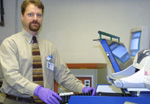Compliance focus of rad safety chief
by Cindy AbolePublic Relations
Understanding radiation safety within a large, active academic medical center is more than just identifying the three magenta propeller blade symbol against a yellow background that signifies a hazard. At least, that's what new Radiation Safety Division manager Jim Rutan wants people to know.
Rutan hopes to expand and develop MUSC's Radiation Safety Program by encouraging others to become more aware of its importance in the workplace. He begins this through improvements in campus procedures regarding the safe handling and disposal of radioactive materials in compliance with state and federal regulatory agencies and improvements in staff education.
 Radiation
Safety Manager Jim Rutan uses the Liquid Scintillation Counter which is
used for counting low level radioactive samples.
Radiation
Safety Manager Jim Rutan uses the Liquid Scintillation Counter which is
used for counting low level radioactive samples.
“MUSC has quite a bit of research that has been ongoing,” said Rutan, a nuclear engineer originally from Springfield, Mo. “MUSC is involved in a lot of cutting-edge technology. There are techniques developed here that are constantly being improved.”
But relocating 2,600 miles cross-country from the Golden State hasn't daunted Rutan and his adjustment to the easy Southern life. He is just as busy and brings with him a wealth of experience which began at the University of California Los Angeles (UCLA) Hospital and Medical Center. At UCLA, Rutan worked as a health physicist, a specialty that combines engineering with safety, specifically in the area of radiation health. He supported radiation safety in the university's clinical and research areas including nuclear medicine, radiation oncology and university research labs.
In 1998, he moved further south just outside San Diego where he worked at The Scripps Research Institute, one of the country's largest private, non-profit research institutions. There, he worked in a more comprehensive safety program where his responsibilities included environmental health and safety issues and managing hazardous chemical waste disposal, as well as directing the radiation safety program.
At MUSC, Rutan manages a team of five health physicists who maintain inventories and review procedures to ensure the safe use of radioactive materials and radiation producing machines. Much of their interaction involves working closely with the Occupational Safety and Health Administration (OSHA) staff in handling radioactive waste disposal, decontamination and active response to spills and emergencies throughout campus.
“Jim has a very important role and responsibility on campus where he must remain poised and balanced,” said Wayne Brannan, University Risk Management director. Both Radiation Safety and OSHA operate under the umbrella of University of Risk Management. “He must perform his job of maintaining compliance while supporting both the health care and research needs of specific users. His past experience and knowledge in radiation safety is a great benefit to us.”
Working with staff, Rutan also supervises radiation safety and exposure rates with radiopharm-aceuticals and patients. It is his job to discuss safety and other precautions with the patient. He also handles the proper disposal of any radioactive waste.
Rutan believes that regulations regarding radioactive materials will eventually force more compliance to national standards. Within the industry, the development and use of new technology is relevant to how these materials are handled within specific environments. For example, the methods for handling and disposing of mixed waste might be different as defined by the state of South Carolina and Environmental Protection Agency (EPA) at MUSC in comparison to the health and safety procedures at UCLA.
“Within our field, good radiation safety officers are hard to come by,” said Joe Avant, OSHA director at MUSC. “We're really excited to have him working with us.”
Ahead on Rutan's agenda is the development of a web-based, interactive training program for staff. He would like to incorporate specific training modules for users to access according to jobs and duties.
“Having this information available online can provide complete, up-to-date
information for staff to access from clinicians and lab specialists to
housekeeping personnel,” Rutan said.